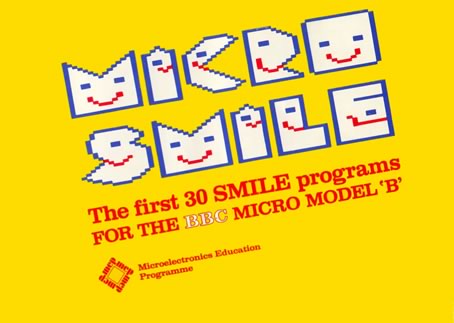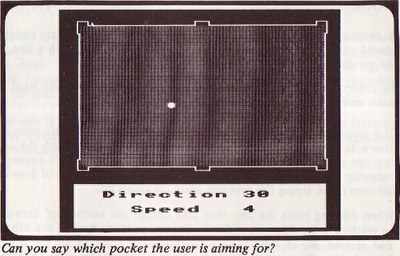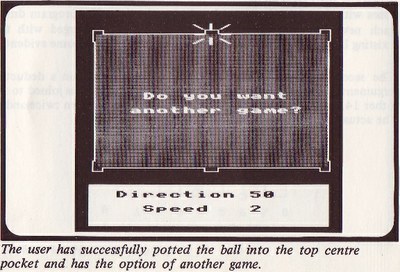Micro Smile
Introduction
 Published in 1984 by the SMILE Centre, this popular set of programs was used widely in many schools to supplement maths teaching.
Published in 1984 by the SMILE Centre, this popular set of programs was used widely in many schools to supplement maths teaching.
The first 30 programs were:
|
Title | SMILE No. | Topic | Difficulty |
|---|---|---|---|
| ANGLE90 | 1721 | Angle | 3 |
| BOAT | 1626 | Logic | 3 |
| BOXES | 1625 | Place Value |
0 |
| CIRCLE | 1702 | Investigation | |
| ELEPHANT | 1607 | Co-ordinates | 4 |
| FACTOR | 1708 | Number Patterns | 5 |
| FROG | 1651 | Investigation | |
| GUESS | 1605 | Place Value | 0 |
| GUESSD | 1606 | Decimals | 3 |
| JUGS | 1652 | Logic | 6 |
| LINES | 1641 | Games | 2 |
| LOCATE | 1715 | Co-ordinates | 5 |
| MASTER | 1653 | Logic | 3 |
| MAZE | 1609 | Logic | 1 |
| MULTIPLE | 0330B | Number Patterns | 4 |
| NIM | 1604 | Game | 6 |
| PILOT | 1667 | Angle | 5 |
| PREDICT | 1691 | Logic | 6 |
| QUEENS | 1714 | Puzzles | 5 |
| RACEGAME | 1654 | Vectors | 5 |
| REFLECT | 1623 | Motion Geometry | 4 |
| REVERSE | 1608 | Puzzles | 4 |
| RHINO | 1621 | Co-ordinates |
3 |
| ROSE | 1731 | Number Patterns | 5 |
| SNOOKER | 1624 | Angle | 3 |
| SPIRALS | 1776 | Investigation | |
| TAKEHALF | 1650 | Shape | |
| TILES | 1617A | Shape | 3 |
| TOWER | 1666 | Fractions | 4 |
| VECTMEET | 1622 | Motion Geometry | 6 |
The programs were translated and enhanced by Pete Smith with the exceptions of GUESS, GUESSD, ELEPHANT, RHINO, SNOOKER and MASTER which are by Siobhan Leahy. The programming was funded by the Microelectronics Education Programme.
The programs are © 1984 Council for Educational Technology
Snooker
The first version of this software was developed by Richard Millwood as a Mathematics teacher at Scott Lidgett School in 1979. Its intent was to simulate a snooker ball, but when shown to school pupils it became clear that it engaged them in an inquiry to find the relationship between number and angle.
Later, it was proposed to make it a resource for the Secondary Mathematics Individualised Learning Experiment project (SMILE). It is resource number 1624 and was developed further for the BBC Micro. In 1984 the SMILE project published 'MICRO-SMILE - The First 30 SMILE programs' and Snooker became part of that package.
This is an extract from the MICRO-SMILE booklet:

Estimate the angle and pocket the ball! The outline of a snooker table is drawn with a ball somewhere on the table. The user is asked for the angle (zero is 'north' with the angles measured clock-wise as in a bearing) and then the speed (1 is slow, 10 is fast).
The ball bounces around the table and if it does not fall into a pocket it slowly comes to a rest for another try.
The program is highly motivating. Children without a full understanding of the measure of angles will enjoy playing and will ask for information. (There is always at least one pocket to aim for with an angle less than 90˚). Also, there is a feed-back for the child since it is immediately clear whether a particular angle was much too big or just too small.

MICRO-SMILE booklet
 19840000 MICRO-SMILE A5 150dpi.pdf
—
PDF document,
5.36 MB (5624699 bytes)
19840000 MICRO-SMILE A5 150dpi.pdf
—
PDF document,
5.36 MB (5624699 bytes)
media
-
 Snooker diagram 1.jpg
—
by
Richard Millwood
—
last modified
Oct 09, 2012 11:02 AM
Snooker diagram 1.jpg
—
by
Richard Millwood
—
last modified
Oct 09, 2012 11:02 AM
-
 Snooker diagram 2.jpg
—
by
Richard Millwood
—
last modified
Oct 09, 2012 11:02 AM
Snooker diagram 2.jpg
—
by
Richard Millwood
—
last modified
Oct 09, 2012 11:02 AM
-
 micro-smile-cover.jpg
—
by
admin
—
last modified
Jan 09, 2013 09:39 PM
micro-smile-cover.jpg
—
by
admin
—
last modified
Jan 09, 2013 09:39 PM

